Here is the main post for Agnes Hoekstra Roorda (1894-1924), Ancestor #4/52
Agnes in the Records
1894 | 22 Feb. Agnes (or “Aggie” as she was known in the family) was born in Iowa–somewhere. I’ve never found a birth record for her. Her parents were Sye Kornelis Hoekstra and Tryntje van Dijk Hoekstra, both immigrants from the Netherlands. Her DOB is confirmed by her death certificate. She was named for her Dutch paternal grandmother, Akke de Jong Hoekstra.
Add: I just heard from a cousin who says she found a birth record for Agnes (it must be Agnes) on FamilySearch. It’s interesting that her birthdate is 21 Feb, not 22. The mother’s name is hopeless–“Typsice”? Is that a mangling of her first name, Tryntje? It fits with the 1895 census that she was born while the family was living in Maurice.
1895 | Age 0. The 1895 Iowa state census for Maurice, Sioux County, Iowa showing “Aggie, age 0” in the family of Sye and Tryntje Hoekstra. My notes say that the family lived in Maurice, Iowa for five years: 1891 to 1896. This record was hard to find because the name was botched by the enumerator, looking something like “Harkstran.”
1900 | Age 6. 8 Jun. The family, including Agnes’s parents and siblings, are living in Floyd Township, O’Brien County, Iowa. There are no particular surprises in this census record, except that the family has moved from Maurice in Sioux County to Floyd Twp. in O’Brien. Agnes’s father Sye Hoekstra is a truck farmer, or “gardener.” The mother’s name has been Americanized to “Kate.” The children ages 10 and younger are in school, except for the children under 5. The three oldest children, Cornelius, age 17 [should be 19], Anna, age 16 [should be 17], and Ranzie, age 16, are not listed as being in school. Probably the three oldest children quit school after the 8th grade.
The Sye Hoekstra family, c.1900. This photo was found in my father’s papers. The handwriting on the front (“Sheldon, Iowa”) is his. The family lived in the town of Sheldon when RJR knew them, so that may be why he identified the location for this photo as Sheldon.
Standing in back: Anna, age 17; Cornelius, age 19. Sitting, second row: Ranzie, age 16; Harry, age 10; mother Katherine: father Sye; John, age 8. Small children in front: Aggie, age 6; Jake, age 3 or 4 (on Sye’s lap).
Verso of this photo:
1905 | Age 11. The family is found in the 1905 Iowa state census, which lists only their names and indicates that their post office was Sheldon, Iowa. So evidently sometime between the 1900 and the 1905 census, the family had settled in Sheldon.
To give some context to the family’s moves between 1891 and 1905, the three areas–Maurice in Sioux County, Sheldon in both O’Brien and Sioux counties, and Floyd Township in O’Brien County–are all within about 30 miles of each other. The two counties of O’Brien and Sioux share a boundary line.
The family had a small amount of land, probably three acres or less, where Sye grew vegetables which he probably sold from a stand at the market, an occupation which would have required the work of many hands. One young worker hired to help on a garden farm which must have been much like Sye’s describes “long, torturous hours of crawling with his legs astraddle as he weeded rows of vegetables” (Brouwer, 25).
1907 | Age 13. I’m estimating Agnes’s age in this photo. Based on other photos that I have of her, I think this is probably close. She may have been older here–closer to 16. She always had such a young-looking face. If Agnes was 13-14, then this was about the time her school days ended. From the census records, it appears that she completed school only through the 8th grade.
By this time, the family was well settled in their home in Sheldon, Iowa, the father Sye running his own garden farming business. One aspect that was probably quite central to the lives of this family was religion and the church. According to Agnes’s mother’s obituary (1924), the family must have been members of Sheldon’s Christian Reformed Church (CRC). I found a note about this church in a the Sheldon Area Centennial, 1872-1972:
Feeling that their church was becoming too liberal, several families helped to organize the Christian Reformed Church in Sheldon on June 24, 1906. With a membership of 17 families, the congregation worshipped in the Adventist Church, then the Baptist Church, and later in the Church of Christ. A small church building was erected on the corner of Ninth Street and Ninth Ave. in 1907. In 1911 the church was enlarged. . . . In 1951 a new edifice was constructed on the same site as the previous church (62).
1910 | Age 16. Agnes and her family are found in the 1910 U.S. census for Sheldon, O’Brien County, Iowa. Sye Hoekstra, Head, age 51, Truck farmer; “Dryntje” [should be “Tryntje”], age 41, wife, married 31 years, 16 pregnancies, 7 living children; Anna, daughter, age 27, Single, working as a “Servant,” Private Family; Harry, son, age 20, apprentice carpenter; John, son, age 17, occupation “None” [undoubtedly he was helping his father with the truck farming business]; Agnes, daughter, age 16, no occupation, not in school; Jake, son, age 13, attended school; Alice M, ad. [adopted] daughter, age 12/12. The two oldest sons, Cornelius and Ranzie, were no longer living in the Sye Hoekstra household.
From this census record, it’s clear that age the age of 16 Agnes wasn’t attending school, which indicates to me that she probably quit her formal schooling in the 8th grade.
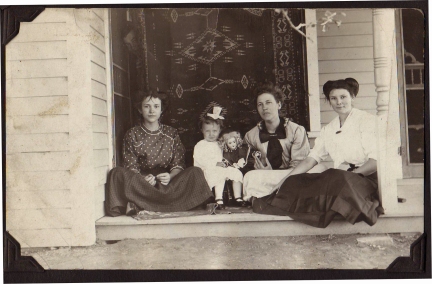
Hoekstra daughters, sitting on the porch in summer. Seated at far left is Agnes (Aggie) Hoekstra; the little girl is Alice, the adopted daughter; third from left is Anna Hoekstra; the fourth young woman is unknown. This photo is dated c.1910-11, based on the apparent age of the youngest child.
This photo of Agnes and her sisters and an unknown young woman is part of what I call the “Anna Book,” a scrapbook of photos collected and saved by my aunt Anna Roorda Cunningham, my father’s oldest sister and Agnes’s oldest child. (1) Anna obviously knew what family her mother came from (she was 12 when Agnes died, and the photo collection shows she was aware of the family), and had she been alive when I started my search for Agnes, she could have been of immeasurable help.
I love this candid photo. Agnes’s face, younger than her years, shows a sweet innocence. If I were guessing her age in this photo, I would say she was 12 or 13, not 16. However, we know 1910-1911 is close because of the apparent age of the littlest girl, Alice.
1911 | Age 17. Summer or early Fall. This is another photo of Agnes that I love. It’s another photo from the Anna Book. I’m speculating that RJR, my grandfather, who was “courting” Agnes at this time, wanted a photo of her, and it would have been immodest of her to pose for him by herself. Consequently, he took this photo of her with her siblings. That’s a wild guess on my part, but it makes sense to me. I love her brother Jake’s bold look at the photographer. It’s a little bit hard to tell in this version of the photograph, but Agnes is shelling corn. The dog on John’s lap is a nice touch.
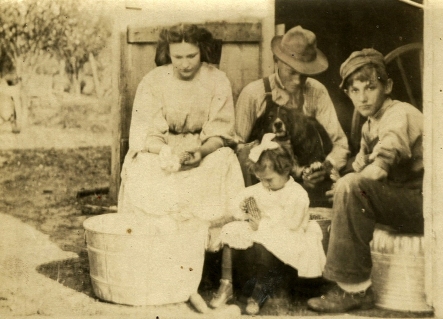
Hoekstra Siblings, c.Sept. 1911. From left to right: Agnes, her brother John in the middle, and her brother Jake. The little girl in front is Alice Marie, the adopted daughter.
What was the occasion for the photograph? According to my grandfather’s (I refer to him as RJR) memoir (2), he was courting Agnes during this time: “I was getting serious about my girl friend A. and was thinking about asking her to marry me. Instead I bought a train ticket. . . ” (TD&H). It was at this time that RJR returned home to the Netherlands for the first time in almost ten years to visit his parents, so we can date the time of his “thinking about asking” and buying the train ticket to New York. There is a New York passenger list that shows “Richard Roorda” arriving in New York on the S.S. Celtic, sailing from Liverpool, on 12 October 1911. If he spent about six weeks visiting family in Friesland, then he must have left Sheldon, Iowa sometime around the end of August. I’m thinking that RJR took this photograph of his “sweetheart” to show to his family in the Netherlands. The timing is right; the rest is speculation.
1911 | Age 17. 22 Oct. From TD&H:
I arrived in S. [Sheldon] on October 22, at the home of A. my girl friend, and soon after we announced our engagement! . . . We set our wedding date for May 29, 1912. So we were a happy couple after I asked A’s parents if they had any objections to my marrying their youngest daughter. They said they were very happy to accept me as their son-in-law!
What wouldn’t I give for the letters that Agnes wrote to RJR at this time! She was living in Sheldon and he was working in another town that started with an “S”–probably Sioux City–working as a bookkeeper and office manager. He says he took the train to see her twice a month during that time, since it was all he could afford. I imagine there were many letters that went back and forth between the two from October to May.
1912 | Age 18. The date of this photo is approximate. Agnes and her older sister Anna were both engaged to be married in the spring of 1912. Anna was considerably older than Agnes–29 years old at the time of her marriage to Henry Buysman. This is another photo found in the Anna Book.
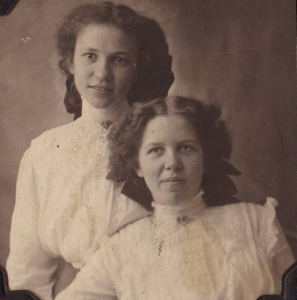
Sisters, Agnes (left) and Anna Hoekstra. Probably taken when the sisters were both engaged to be married, spring 1912.
1912 | Age 18. 29 May. The marriage of Richard J. Roorda and Miss Agnes Hoekstra was announced in the Alton Democrat. She was married at her parents’ home in Sheldon, Iowa. The marriage record found at O’Brien County, Iowa gives their names as Richard J. Roorda of Woodbury County, Iowa and Agnes Hoekstra of O’Brien County, Iowa. Anna Hoekstra, Agnes’s sister, was the witness for obtaining the license on 27 May 1912. Richard was 24; Agnes was 18.
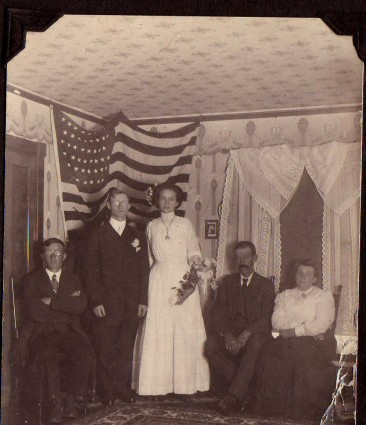
Marriage of Richard J Roorda and Agnes Hoekstra, May, 1912. The wedding took place in the bride’s parents’ home. From left to right: Gerrit Roorda (the groom’s brother), RJR, Agnes, the bride, Sye Hoekstra, Tryntje Hoekstra.
RJR was very short–probably 5’4″ at most. It’s possible that at the age of 18 Agnes hadn’t reached her full height, although even here she’s taller than he is. I guess most people were taller than he was–ha. This is the only photo I’ve found of them standing together. It’s interesting to note that from the time of their engagement to the time of their marriage, RJR had changed jobs–from “bookkeeper” at the bank in the Fall of 1911 to “salesman” in a department store in May of 1912. “Change” would be a constant theme of their married life for as long as Agnes lived.
One question I have about Agnes and RJR’s wedding: Who was the Rev. F. Stuart, the person who performed the wedding ceremony at Agnes’s parents’ home? What church did he represent? Agnes Hoekstra came from a religiously conservative household, her parents members of the Christian Reformed Church in Sheldon. It seems to me unlikely that they would have anyone but the CRC (Dutch) pastor perform the wedding. And yet, especially in 1912, I would normally expect a pastor from the conservative Dutch church to have a Dutch name. –Well, there’s this: according to the 1920 census for Holland, Iowa, there are several families named “Stuart” from the Netherlands.
Then there’s this from TDH: The day after the wedding, RJR and Agnes took the train to their new home, “S.C.” as RJR cryptically writes. Candidates for a nearby town with the initials S. C. are Sioux City, a town about 60 miles from Sheldon, and Sioux Center, a town about 30 miles from Agnes’s home. It’s likely that the town RJR was referring to was Sioux City, since he says that S.C. was “a big change for my darling wife.” Another “big change” for Agnes seems to have been the church she was attending. Agnes came from a family who attended the Dutch church, the Christian Reformed Church (CRC) in Sheldon. Records show that RJR was baptized in 1906 in the Reformed Church in Maurice, Iowa. I have always associated my grandfather with the Reformed Church, the church he attended all of his adult life once he moved to Denver, which came after Agnes died. Yet RJR writes:
This was a big change for my darling wife, but in allowing her to choose in several ways, including what church, she decided to go with me to the Methodist Church, and we both became active members and loved every one in it!
Well, “loved it” with qualification, it would seem, since in the very next sentence he writes:
I soon realized that A. Was not happy with the ‘big city’ and when an opportunity came to accept a position in a farmer’s town of 2,000 in C., So. Dakota as bookkeeper for a Farmers’ Co-Op, I accepted same with a raise in salary.
From a note in his Family History book, we know that “C., So. Dakota” was the town of Clark. How long was the newly married couple in Sioux City? That we don’t know for sure. However, it may have been just long enough for Agnes to contract the tuberculosis that would plague her for the rest of her life. The fact that she contracted TB when she lived in Sioux City is speculation. The fact that she had the disease by the time she had her first child on 5 April 1913 is an accepted fact within the family lore. However, I’m getting a little bit ahead of myself. From the same paragraph, a sentence or two down the page:
My wife and I were both very happy in this farmer’s town, me with the work and she in home and church. But this was not the case with her mother, who begged us to live closer by, and when the following spring, 1913 arrived, I made application for bookkeeper in the S. State Bank (3) and was readily accepted because I was able to talk, read and write the language of the Hollanders moving into the territory real fast. Here on April 6, 1913, our first baby, Anna, came to us, but also I found that my loving wife had T.B. which explained why she was so often ailing and had to go slow, on doctor’s order.
In a Personal History and Family Record Book filled out by RJR sometime in the 1960s and in my possession, RJR records that his first child was born in Sanborn, Iowa. Sanborn was probably a bit smaller than Sheldon, but it was nearby–only about 10 miles. According to the family record book, the farm was near Sanborn.
After saying that the bank turned down his request for an increase in his salary of 25%, from $75 to $100 a week (after being there for how long–a month?), RJR says that he and Agnes made yet another move:
As we were both fond of the farm, I resigned from the bank when I had a chance to hire out to a bachelor farmer, who wanted a man and wife, so he offered us the same salary, plus room and board!
1913 | Age 19. 5 Apr. RJR and Agnes’s first child was born, Anna Dorathea Roorda. The evidence for her birth in Sanborn, O’Brien County, Iowa comes from RJR’s Personal History and Family Record book, filled out sometime in the 1960s. Dr. Horton delivered her “at home.” She was baptized in the Methodist Church.
Presumably, since the record shows that Anna was born in Sanborn, the family also attended the Methodist Church in Sanborn: St. Andrew’s Methodist Church. The brick building was erected on the corner of Main and Fourth Streets, dedicated 17 January 1909, as St. Andrews Methodist church, Pastor, the Rev. Charles H. Seward.
Research into the records of St. Andrews for this family needs to be done to see if this is indeed the church they attended. In the family record book, RJR states that he was a member of the Methodist church in Sioux City, Iowa, Clark, So. Dakota, Sanborn, Iowa, and Burlington, Colo. His notations about his childrens’ baptisms bear this out.
1913 | Age 19. So let’s call this July, 1913, and maybe a reality check would be of some help. Agnes was married in May. As a new wife, she went to live in Sioux City, Iowa where her husband, who had been a bookkeeper six months before the marriage, now worked as a salesman in a department store. But then, according to RJR, Agnes’s unhappiness and ill health [?] caused them to move to a town in South Dakota where he kept the books for a farm Co-Op. But then, despite the couple’s happiness with their living situation, they moved to Sanborn, a town near Sheldon, to please Agnes’s mother, where he worked for the bank. There in Sanborn her first child was born in April of 1913. Then RJR either quit his job, where he was making $75 per week, or was fired–we never quite know–so RJR and Agnes rented themselves out as a couple to work on a farm–this “often ailing” wife who had been told by her doctor to “go slow.”
Fourteen months, one new marriage, a new church, one new child, a new case of tuberculosis, and four new jobs and changes of residence. This would pretty much be the pattern of Agnes’s life until her death, 13 years later.
1914 | Age 20. A sample of Agnes’s handwriting. On the other side of this post card is a photo of her daughter Anna.
1914 | Age 20. 19 May. RJR and Agnes’s second child was born, James Richard Roorda. The family was still on the farm near Sanborn and, like his sister, James Richard was also baptized in the Methodist Church.
The next photo, of Agnes’s two oldest children, is another one from the Anna Book.
Anna’s little dress looks similar to dresses found on Agnes’s sister’s children (Agnes’s sister, Anna Hoekstra Buysman). Someone in the family evidently did beautiful work, sewing special clothes for baptisms, etc. or possibly just to wear to church. This is a 1927 photo of Anna, baby Andy, and daughter Mildred:
1916 | Age 21. 12 Jan. Another year, another baby. RJR and Agnes’s third child was born, Cyrus Edward. RJR writes in TD&H: “That winter our 2nd son Cyrus was born, January 12 during a terrific cold night. Dr. Horton almost froze his feet coming only three miles.” Cy was also baptized in the Methodist Church.
Life on the farm sounds like it was a tough haul during 1916 and 1917. RJR writes of 1917: “And that year we froze out again. When the fall of 1917 arrived, my dear wife, mostly sick, the doctor advised a higher climate for her.” Not only mostly sick, but also mostly pregnant. I wonder if the doctor didn’t also advise slowing down on the childbirth.
1917 | Age 22. 5 Sep 1917. RJR and Agnes’s fourth child was born near Sanborn, their third son, Garrett Cornell, also baptized in the Methodist Church. From TD&H:
We hated to tell the relatives about our decision to leave Iowa, and only said it was for health reasons, without making further explanation. On September 5, 1917, our third son, Gary, was born, and we made preparation to leave! After the corn crop was gathered, and the hogs and calves were sold, we called a public sale, but kept enough back so that we could start farming again in Colorado. I arrived there December 17, 1917.
The family moved from Iowa to Burlington, a town on the eastern prairie of Colorado, not far from the Colorado/Kansas state line. The next line in TDH gives me pause: “my wife arrived with the four children by train.” I so hope someone in the family went with “mostly sick” Agnes to help her with the four children, ages 4, 3, 1, and a newborn. Somehow, however, I imagine her making that trip by herself.
When she got to Burlington, one can only imagine her state of mind. The only place that RJR had been able to find for rent was a “shack” (his word) that had once been a jail. Presumably they didn’t stay there long, as he writes that a Burlington real estate dealer offered him the use of the basement of his two-story building in exchange for firing the furnace and cleaning the man’s office. “This we did for the rest of the winter months,” and in his “spare time,” he says, he helped finish building the Methodist church (“which we joined”). The very next line is this one:
We loved our new home and the people around us, but we realized that farming and improving our own 160 acres of prairie was impossible financially.
At this point, I think it best to pull the curtain over this family tableau with all of RJR’s missteps and job changes; it is simply too painful to detail. Suffice it to say that Agnes’s life goes on this way until 1919, with RJR finding work as a day laborer doing construction and, more promising perhaps, figuring income taxes for businessmen and farmers who were relatively new to paying the tax. Farming, for him, just seems to have been out of the question.
1918 | Age 23. I estimate that this photo of Agnes’s children was taken in the summer or early fall of 1918, based on the apparent age of Gary, the youngest child, who must have been about a year old. Despite the moves and job changes, , the children look well-fed and happy, and clearly they must have been the center of Agnes’s life.
1918 | Age 23. 19 Nov. RJR and Agnes’s 5th child was born, John. Born in Burlington, according to RJR’s Family Record. There is no specific mention of John’s baptism, but undoubtedly he was also baptized in the Methodist church.
RJR is, as usual, writing about his various jobs and job changes in 1919, obsessing about should he or shouldn’t he yet again change his job, and pointing out that he had to make the job decision “by myself.” This is the context in which we are told that Agnes “had been sent to the Methodist Sanitarium for T.B.”
RJR gives us no details about the T.B. sanitarium where Agnes was sent. There was one run by the Dutch church in Denver called Bethesda, and I suppose I always assumed that Agnes had gone there for treatment. However, RJR must have been depending on the church for help with his very sick wife; they were members of the Burlington Methodist church, and he specifically says she was sent to the Methodist sanitarium. Therefore, it couldn’t have been Bethesda where she was treated. She may have gone to some precursor of the National Methodist Sanitarium, which opened it’s 4-story building in Colorado Springs in 1926. Perhaps there was a facility that was closer to Burlington, maybe somewhere in Kansas. Regardless of where she went, it would seem that Agnes didn’t stay long. RJR writes:
My wife was so homesick at the hospital, so Dr. told her if she could remain quiet at home as in there, she would be better off in her home, so that meant for us a maid to do most of the housework. Father and mother H. had heard and guessed the rest about their daughter, so she came to visit us from Iowa, which was much appreciated, and she thanked me for taking A. away from the climate where she could not regain her health.
There’s so much to unpack from those two sentences, I hardly know where to begin. Maybe I should begin with this photo. Although he doesn’t say so in his memoir, the children must have been sent back to Iowa to be taken care of by relatives. This photo is another one from the Anna Book, with Anna’s description written at the bottom:
The contrast between this 1919 photo of Agnes’s children and the one from just a year earlier is haunting. The very healthy-looking “Loopstra child” is RJR’s sister’s son, Peter Loopstra, born in 1918, the same year, although probably several months before, poor little John Roorda, shown on his brother’s lap. It looks to me like the children have had their heads shaved, perhaps because of lice. We could tell for sure if we could see Anna’s head, but she’s wearing a hat and looking away from the camera. The older boy next to her is Jim, then Cy, with baby John on his lap, and Gary at the far left. Rena Loopstra and her husband Fred were living in Sheldon, Iowa, according to the 1920 census, where Fred worked as a carpenter. It is possible, although I think it unlikely, that Rena traveled to Burlington to take care of the children. I’m imagining that Grandma Hoekstra took it upon herself to take the children back to Sheldon where both she and Rena could care for them until their mother was able to take over. However, the place of the photo isn’t definitive.
Of course no one believed that a woman could stay “quiet” in a home with five children under the age of seven. However, Agnes must have been very convincing, and it’s easy to imagine how much she wanted to get back to those children if she was feeling even a little better. Agnes was a strong and determined woman, no doubt about it. Sometime in his 60’s, Agnes’s son Garret Roorda wrote some reminiscences about his early childhood. It was one of the times mentioned in RJR’s memoir when he was farming. Garret says this was the first home he remembers, so it was early days in Burlington when RJR was still trying to farm, probably shortly before Agnes went to the sanatorium. Gary writes:
The first home I remember was the farm of ‘640 acres southeast of Burlington with a huge barn and a livable house,’ described in Tom, Dick, & Harry. An incident on that farm establishes a fact about my mother that explains what kind of woman she was. While plowing with a team of horses in a field on this farm, the team was spooked by something that caused them to bolt and run away. In an effort to stop them, my father was run over, injuring his leg; the horses ran for home and stopped at the barn where my mother saw the driverless team and plow. She ran to the field, I tagging along as fast as I could.
‘I’ve hurt my leg,’ said my father. My mother pulled up his overall pant leg to see. What she saw was a bent shinbone. She clamped her hands around the bone and in one motion squeezed it back in shape until the tibia was straight.
‘There,’ she said, ‘that’s the way your leg should look.’
Gary says it was no accident that Agnes was able to deal with RJR’s broken leg (She was, he said, given “high praise” from the doctor when he arrived.). Gary believed that during her teens, Agnes had taken a course in practical nursing,(4) “that gave her a quality of caring and insight that greatly formed me as a child.” She also had something that the children called “Mama’s Doctor Book,” which Gary says he spent many hours paging through as a child–“a vivid pictorial of human anatomy in color, with layered leaves.” It may have been a book well-known to people in the early 1900s: The People’s Common Sense Medical Advisor, by R.V. Pierce, said to be one of the most popular home medicine books of the late nineteenth and early twentieth centuries. The book promoted an ideology of maintaining health through education about the body, something that would have come in handy for a mother of five out on prairie farm.
1919 | Age 24. 14 Nov. The year 1919 was, quite simply, a terrible year for this family. Baby John died on November 14. In TD&H, RJR says he died of “brain fever.” In his Family Record book, he says it was pneumonia. I have only one picture of John, the one of him sitting on his brother’s lap. He’s probably about nine months old in that photo, and he looks like a child who might be diagnosed today as failure to thrive–he looks extremely underweight, especially compared to his fat little cousin. Whatever the cause of his death, it must have been devastating to the couple. What it his death that caused Agnes to insist on returning home from the sanatorium, or did he die after she returned home? RJR says in TD&H only “John, who was taken away at the age of 11 months.”
1920 | Age 25. 1 Jun. RJR (Richard Roorda) and Agnes are found in the 1920 census for Burlington, Colorado. They apparently own their home on Nineteenth St. (no house address given). RJR is working as a Bookkeeper at the Grain Elevator. The census is inaccurate in that it gives Agnes’s naturalization status as “Alien” which of course is incorrect since she was born in the United States.
Head of household: Richard Roorda, age 32, immigrated 1902, “Al” (naturalization status: Alien), b. Netherlands; Agnes, age 25, b. Iowa, occupation none; Anna, daughter, age 6, b. Iowa, in school (Anna is the only child old enough to attend school); James, son, age 5, b. Iowa; Cyrus, son, age 3, b. Iowa; Gerrit, son, age 2 3/12, b. Iowa.
A photo of the family at about the time of the 1920 census:
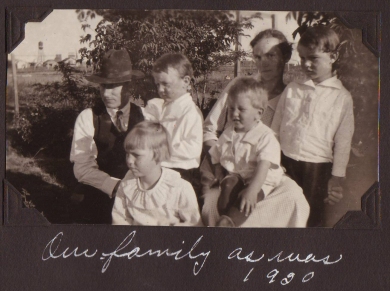
From the Anna Book. The caption reads: “Our family as was 1920”–written under the photo in the album by Anna Roorda Cunningham. It’s clear in this photo that Agnes is very thin–probably the effects of her illness.
The census must have been taken shortly before the time that RJR lost his job because of the drastically falling price of wheat, which dropped in two weeks from $2.20 per bushel to 82 cents. Although in RJR’s memoir, he makes it sound as if he lost this job right away; however, according to written accounts of what was happening in the family as late as 1923, they were still living in the Burlington home. From TDH, no date attached to this entry:
In the meantime I had taken a job as clerk in a grocery store, which allowed us the barest of living.
RJR says that forever after he blamed the Republicans under President Hoover “for this catastrophe!” which made him a life-long Democrat [obviously he meant Harding instead of Hoover, who was elected president in 1920]. He says it took him a good many years to overcome the loss. According to the 1920 census, RJR had managed to buy a house in Burlington, and he had a steady job that paid well. He must have felt like the family was finally on strong footing, and losing his job because of an economic crash must have been hard to take.
1921 | Age 26. 17 Oct. Agnes’s sixth child was born, Marie. From the Family History:
Marie, born Oct. 17, 1921, but had to sacrifice her life while being born, to save her mother who was hemorrhaging and losing her life’s blood.
In the fall of 1921, Agnes’s other children were ages 8, 7, 5, and 4. The family was still living in Burlington, so Marie’s birth and/or death records would be found there, if they exist.
1923 | Age 27. 15 Jan. RJR and Agnes’s 7th child (5th living child) was born, Richard Kenneth. The Family Record indicates he was born in Burlington at “Guthrie’s Home,” attended by Dr. Bergen. Clementina Guthrie was a midwife who attended births at Guthrie’s Home. Dr. Bergen evidently also was involved, perhaps because of Agnes’s complicated medical and obstetrical history. Richard was baptized when the family moved to Elphis, Colo. by the Rev. van Dellen in the Christian Reformed Church, the first child not baptized in the Methodist church.
1923 | Age 28. 2 Aug. My uncle, Agnes’s son Garret, wrote to me some of his memories of the early Colorado years. He says the earliest memory that he can date exactly is the day that President Warren G. Harding died, August 2, 1923. The family was living in a house at the west end of Burlington that was set on an entire block. The 1920 census indicates this was 19th Street. What would be 19th Street in 2015, if the street numbers are followed logically, is Cherry Street on a Google map of Burlington. The windmill stood near the house. The long path leading to the outhouse separated the two plots of land where the family did some gardening, watered by the windmill. Gary remembers looking out their dining room window and seeing the flag on the court house flying at half staff for the dead president. This was evidently the house they were living in when the 1920 census was taken, so for a few years they seem to have had some stability.
In the same letter, Gary wrote that it was in 1923 that the family moved to Elphis, Colorado, the community of 20 or 30 families that included many Dutch immigrants.
A check of the 1920 census for Elphis, Colorado (Precinct 4, Kit Carson County, Colo.) shows 16 families in this small community who had Dutch surnames: Smit, Jacob (b. Holland); Rootleib, Jacob H (b. Holland); Hoogdalem, Henry (b. Holland); Vandergouwen, Peter (b. Holland); Van der Kooi, Charley (b. Holland); Brouwer, James (b. Iowa; parents b. Holland); Eggink, Antonie (b. Holland); Franken, Gerrit (b. Holland); Vandermeer, Klaas (b. Holland); Weststeyn, William (b. Holland); Kuiper, John (b. Holland); Brownwood, Nicholas (b. Netherlands); Nauta, William (b. Friesland); Dolfin, Katie (widow, b. Holland); Dolfin, Peter (b. Indiana, parents b. Holland); Elzinga, Nicholas (b. New Jersey, parents b. Friesland).
In a letter, Gary described Elphis to me this way:
The family moved to Elphis in 1923 when Dick [Richard, born January 1923] was a baby. In the community there was a country store, a school, two churches, one Nazarene and the other Christian Reformed, a cemetery, and about two dozen farms scattered over an area of 3 or 4 miles in radius. RJR ran the store where the farmers came to trade their eggs and cream for groceries and supplies. He also ran a small farm with cows, horses, pigs, chickens, etc. It was a tough life, but it was also a friendly neighborhood, bound together mainly by the school, the church, the store, etc.
In his memoir, RJR says that he had heard the owner of the grocery store in Elphis wanted to move to California, so the store was for sale. “Most of his reliable customers were Dutch,” writes RJR. “They agreed to turn it over to me for the equity that I had in my home in Burlington.” From TD&H:
Soon we were selling groceries, dry goods and hardware, besides gas and oil for the few (Model T) fords. In addition we had bought 6 milk cows and 100 chickens, with enough machinery to farm 160 acres, plus pasture for the livestock. In addition I took over the Postmastership at a guarantee of $25 per month. We were also buying the farmer’s cream for a creamery on a commission basis. You can see how busy we were, but we loved it, and the people around us. My wife A. had a girl helper every day, and I had a man help me from time to time.
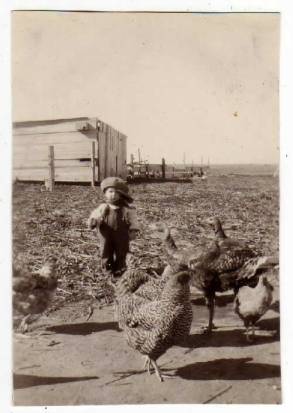
Agnes’s youngest child, Dick, or “Junior” as he was called in the family. Taken after the family moved to Elphis, Colo. Probably summer, 1924.
1924 | Age 30. April. Agnes received word that her mother in Sheldon, Iowa was ill. It was reported in De Volksfriend, a Dutch language newspaper published in Orange City, Iowa, that the children were in town to visit their sick mother in the hospital: Mr. and Mrs. R Hoekstra from Sibley, Iowa; Mrs. H Buisman from Chandler, Minn.; Mrs. Roorda from Elphis, Colo.; C. Hoekstra from Wood River, Nebraska.
This is from TDH:
Then it was in the fall of 1923, we received word from the relatives that Mother H. had to undergo an immediate operation for gall stones and infected gall bladder. I told A. (my wife) to go home, keep house for Dad H. and be with her mother, and also told her if mother does not make it, then stay with Dad for some time, and if her lungs could take it, we would sell out and move back to Iowa. Mother died on the operating table and A. was with her Dad six weeks when he and her brothers and only sister advised her to go back to Colorado as she [Agnes] was failing fast.
Because of Agnes’s mother’s obituary, and also articles in De Volksfriend, we are able to track the inaccuracies and inconsistences at this point in RJR’s memoir. Agnes’s mother, Tryntje van Dijk Hoekstra, died on 6 April 1924, not in the fall of 1923. She did not die on the operating table. From the obituary of Mrs. Sye Hoekstra from the Sheldon Sun, 9 April 1924:
Mrs. Hoekstra has been suffering for the last year with gall bladder trouble which took on an acute form towards the last. She was removed to Myers Hospital where she was operated upon for gall stones, no less than 50 stones having been removed. The operation was very successful and Mrs. Hoekstra was doing nicely. But due to her weakness pneumonia set in which caused her to linger for almost two weeks. Then for a week she rallied nicely, and all hopes were again cherished that she would recover. But the long siege proved to be too much for her, and the last week she failed gradually. . . . She suffered very much at the hospital for four and a half weeks, but had the best of care, having had the attention of a special nurse from beginning to end.
Which begs the question(s): How long was Agnes in Iowa? How could RJR possibly have run the store and home without her? Where were the children, especially baby Richard, while she was in Iowa? Was he seriously contemplating selling out and moving back to Iowa if Agnes’s mother died? What was wrong with this man that he couldn’t seem to stick to anything?
So what is the “failing fast” comment–that Agnes’s family advised her to go home to Colorado because she was “failing fast”? It would seem that in April her family was seriously concerned about Agnes’s health, but it’s also a surprise that RJR would admit that in the memoir. It would also seem like the last place the family would send her if they thought she was “failing fast” would be back to Colorado where she would have so much responsibility for taking care of 5 children, her home, the farm, and the store.
1924 | Age 30. 19 December. Agnes died suddenly while working at home. Despite the “failing fast” comment, RJR maintained at the time of Agnes’s death and also years later when he wrote the memoir that Agnes was doing well before she died, although perhaps working too much–which to him only proved that she loved life. From TD&H:
In short, everyone was happy and doing fine. My dear wife especially enjoyed life very much, which she proved by many times doing more than she should.
This is a short entry found in De Volksfriend for 26 Feb 1925 [the original is written in Dutch; the translation is a paraphrase]:
Alice Hoekstra is expected home from Elphis, Colo., where she was staying for a few months. She was called there to her sick and dying sister, Mrs. Dick Roorda. Alice remained there for some time to be helpful in that family; but now will again provide support for her father, Mr. S. Hoekstra.
In the very next issue, despite all of the work and distractions he must have had, three months after his wife’s death, RJR wrote this to De Volksfriend for 12 Mar 1925 [again, the original is in Dutch; the translation is a paraphrase]:
Alice Hoekstra went back to Sheldon, Iowa to help her father, Sye, Hoekstra. She did not, however, come here to the sick or dying sister (according to the Sheldon correspondent). For there was no problem here. Busy with her daily work, safe and sound, she fell to the floor–a corpse.
This is the way the account of Agnes’s death reads in TD&H:
In the early part of December, 1924, we had a terrific snowstorm, and the snow was from 3 to 6 feet deep everywhere. Our church had decided to have an all out Christmas program; both we and our children were heavily engaged in it. On a terribly cold morning, December 19, both of us were working hard to take care of our school children, livestock, etc. and waiting on customers coming into the store for supplies. A. was flitting from store to house, and back again, when our hired girl hollered at me, “Come quick!” I ran to the house and found her on the floor in a dead faint. She opened her eyes, threw her arms around my neck and whispered, “Oh! such a pain!” Then she inhaled and exhaled just once, and was gone!
It’s not my intent here to argue RJR’s account of his wife’s death. Clearly he was in denial about the nature and seriousness of her illness. And clearly as well, Agnes enabled that denial. If she was not going to get well, then to live her life as fully as possible for as long as possible seems like a courageous act. What I wonder is whether or not Agnes’s family blamed RJR for Agnes’s early death. I also wonder how much guilt he carried with him, and for how long. Is it possible that it was his guilt, as much as anything else, that caused the silence in the family surrounding the stories about his first wife? Later, on any of the (extremely) rare occasions when my grandfather’s early life was referred to at one of those Sunday get-togethers, it was hinted that his first wife was beautiful, his second wife (as anyone could see) was not, and so to preserve the second wife’s feelings, the first wife would not be mentioned.
Since he’s one of the only people in the family I know who has ever been willing to speak about her, I’ll let my Uncle Gary [the Rev. Garrett Roorda] have the this last word about his mother, Agnes, from a letter he wrote to me dated 1996:
Agnes Hoekstra Roorda, my mother, died at the age of 33, having borne seven children, two of whom died in infancy between me and my brother Dick, Jr., and she carried an eighth with her to her grave. . . . As I re-read my father’s account of her in Tom, Dick, & Harry, I see more and more what must have been a heroic but tragic life for her. A memory that I mention reluctantly: my parents had bitter quarrels, my father always having the last word. My mother was verbally abused, and I resented my father for it. I loved him, too, and respected him, but I haven’t forgotten.
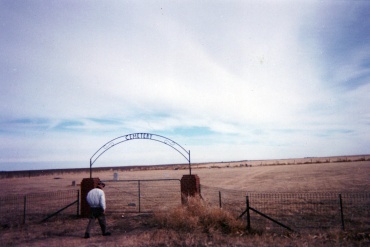
Garret Roorda visiting Agnes Hoekstra Roorda’s grave, Smit Cemetery, 16 miles north of Vona, Colorado
Gary confirms in the letter that Agnes had tuberculosis, that his “naps,” which he hated, were “essential to her in her state of health, with tuberculosis, a weak heart, and being constantly pregnant.” Curiously, however, Agnes’s death certificate doesn’t mention anything about TB. Even though she was only 30 years old, and even though she died suddenly, there was no autopsy. Cause of death is listed as “Chronic Valvular Heart Disease.” The contributory section is blank. The document is signed by the coroner, who more than likely was not an M.D..
Agnes was buried on Christmas day, 1924, at Smit Cemetery, the cemetery that was part of the Elphis community. The church once stood one-half mile south of the cemetery, but all traces of the community with the exception of Smit Cemetery have disappeared. The cemetery is well-maintained due to the efforts of an active cemetery board in Kit Carson County. According to Gary, the graves of her two children who lie with her in the cemetery were a later addition, moved from the Burlington Cemetery by RJR.
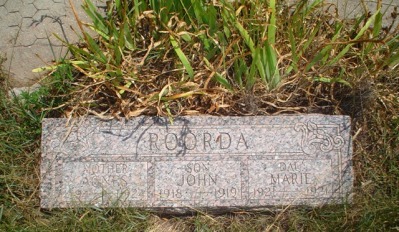
ROORDA: Mother Agnes (1894-1924), Son John (1918-1919), Daughter Marie (1921-1921). The photo was taken c.2009
Research Questions
1. Did Sye own his house and land in Sheldon? Check out land records.
2. Methodist–really? Research into the records of the St. Andrews Methodist Church needs to be done to see if that’s where the Roorda children were baptized.
3. Where was Agnes treated for her T.B.? What Methodist sanatorium was the likeliest candidate for her treatment in 1919?
4. The family probably belonged to the Methodist church in Burlington during their Burlington years, about 1919-1923. Check out the records for the Burlington Methodist church.
5. What records can be found in the county courthouse in Burlington for Kit Carson County? RJR was living in a house that he owned in 1920. Records for the house and other land records should be researched.
6. Now that I know she was born in Maurice, Sioux County, Iowa, I should look at the records at the county courthouse–at Orange City–to find a birth record for Agnes.
7. What was the address of the old courthouse building in Burlington. Gary says they could see the flag flying at half staff from their dining room window.
8. What was the name of the newspaper in Burlington when RJR & Agnes lived there? It might have been the Burlington Record. It would be interesting to see the newspaper for the years between 1917 and 1923.
9. Find the original death certificate for Agnes in the Kit Carson County courthouse. The certificate I have is a copy written out by an office clerk when I sent for the record. Is it possible that the clerk left something off? There’s nothing on the certificate for cause of death but “Chronic Valvular Heart Disease.” If she died of tuberculosis, wouldn’t they have been required to put that on her death certificate?
Notes
(1) The Anna Book. This is how I refer to a scrapbook of photos collected and preserved by my father’s oldest sister and Agnes’s oldest child, Anna Roorda Cunningham. This scrapbook contains about 40 to 50 photos, most of which I had never seen before about 2005, when I received them. They chronicle Anna’s mother’s life from about the time of her engagement to RJR in 1911 to her early death at the age of 24 in 1930. This scrapbook is an invaluable family resource, since Anna is no longer alive to tell us her stories about her mother. The scrapbook went from Anna to her brother Gerrit, from Gerrit to his daughter Judy, from Judy to me. I put out the word to the family that I was looking for photographs, letters, or other documents about the family, and my cousin Judy was kind enough to give me this photo album.
(2) Memoir written in about 1964 by Richard J. Roorda, Tom, Dick, & Harry (TD&H hereafter). Typed copies of this memoir were handed out to all of RJR’s children. I have a copy in my possession. This memoir deserves a post in itself. Unfortunately, RJR either changed people’s names entirely (he was “Harry,” for example) or he used initials. He also used initials for cities and towns. Many of his dates seem to be approximate, although he doesn’t acknowledge when he is estimating a date. For example, he refers to an event happening on “April 1” for about ten different years of his life, which is unlikely.
(3) It’s unlikely that RJR was hired in 1912 or 1913 at the Sheldon State Bank, since that bank failed in 1903, according to the Sheldon Centennial (74). It was probably the Sanborn State Bank, an institution in existence from 1883 to 1924.
(4) If Agnes was doing some sort of “practical nursing” in her teen years, perhaps from age 16-18, then it’s possible that she contracted the T.B. during this time, and not, as I’ve always believed, when she and RJR were first married and living in Sioux City. No one else in her family had the disease, so it’s necessary to look for a source for the infection that was outside of the Hoekstra home. Also, no one else in the Hoekstra family came down with the disease, so if she did contract it while she was “nursing,” if that’s what she was doing before her marriage, then it must have happened shortly before her marriage.
References
Brouwer, Jacob. “Garden Farming in Roseland.” Origins, Vol. XIV, No. 1, 1996. 25-31.

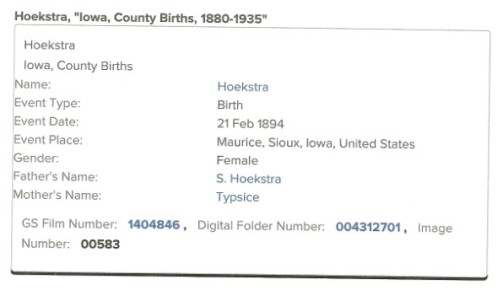
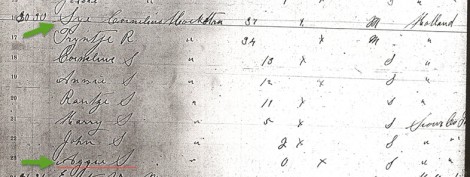

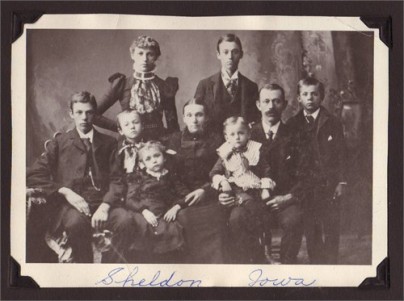
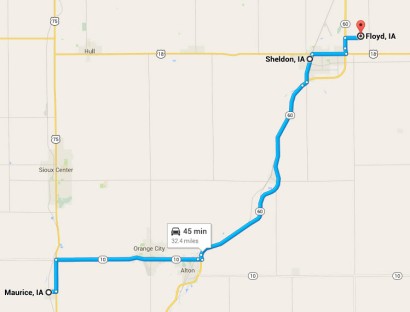
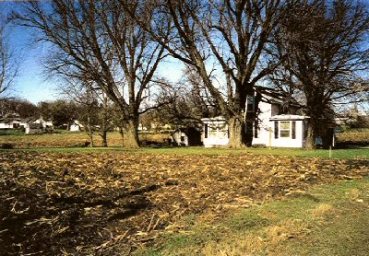
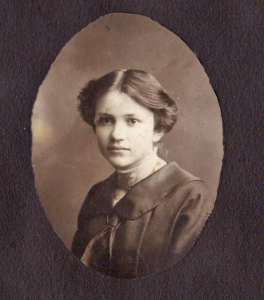

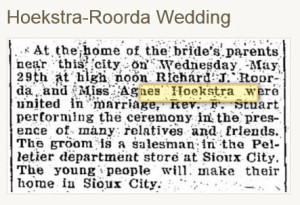
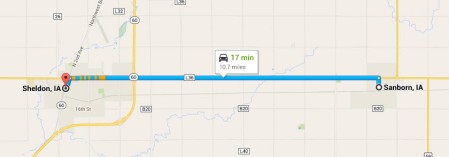
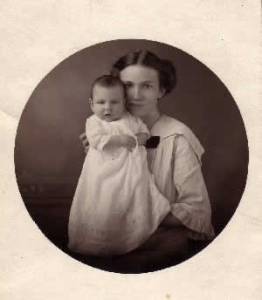
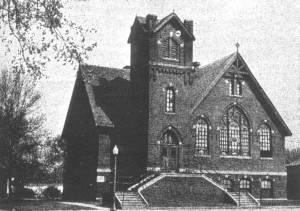
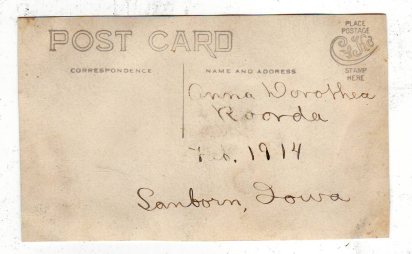
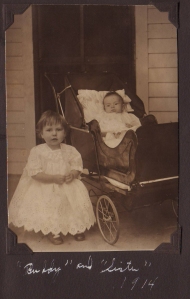
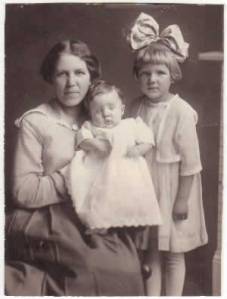
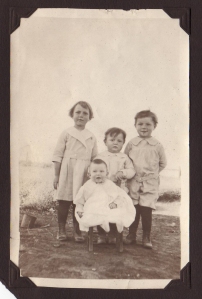
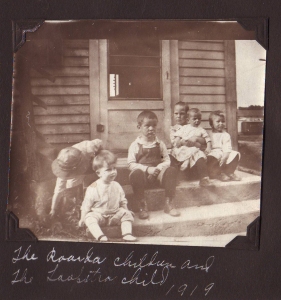
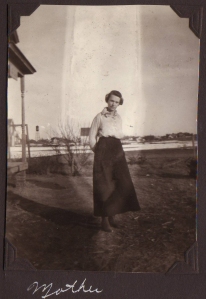

Pingback: 52 Ancestors: #4 of 52 – Close to My Heart, Agnes Hoekstra Roorda (1894-1924) | The Shoebox Under the Bed